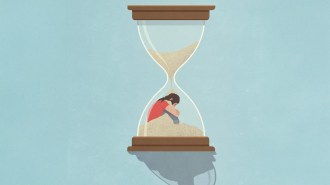Neighborhood unity offers behavioral protection for poor kids
In deprived areas, youngsters’ misconduct declines when community members know one another well.
From a child’s perspective, not all low-income neighborhoods are alike. Though opportunities for youthful fighting and law breaking abound in impoverished areas, good neighbors can nudge youngsters toward the straight and narrow, according to a five-year study led by psychologist Candice Odgers of the University of California, Irvine.
When a low-income community has a high level of a trait known as collective efficacy, 5-year-olds are less likely to fight, steal and engage in other misconduct, Odgers and her colleagues report in the July Developmental Psychology. Members of communities with high collective efficacy are close-knit and willing to intervene on behalf of the common good, say to prevent children from spraying graffiti on a local building or to prevent city officials from closing a nearby fire station.
Collective efficacy in low-income neighborhoods was associated with lower levels of aggression and physical violence by kids at age 5 but not at ages 7 or 10. This pattern held even after the researchers accounted for crime rates in different neighborhoods and family factors that contribute to early delinquency, including extreme poverty, physical abuse of children, domestic violence and parents’ past criminal activity.
The trait offered no protection against misconduct for children growing up in affluent neighborhoods, according to the researchers.
“Our findings suggest that some deprived neighborhoods contain important assets, such as collective efficacy, that have a positive influence on children’s behavior,” Odgers says.
Collective efficacy may result in neighbors enforcing good behavior among children when parents aren’t around, she suggests. Close ties among neighbors might also lower children’s stress levels, leading to better behavior.
Overall, the new study “provides a compelling case” for collective efficacy having a role in protecting poor children from developing aggressive and delinquent behavior, says psychologist Kenneth Dodge of Duke University in Durham, N.C.
If collective efficacy boosts parents’ child-rearing ability, perhaps by eliciting assistance and advice from neighbors, that may explain why a link to improved behavior appeared only among 5-year-olds, Dodge says. After starting preschool at age 5, kids spend much less time with their parents and more with their peers.
As kids in the study reach adolescence and spend unsupervised time around adults in the community, Odgers suspects, collective efficacy will again influence misbehavior and delinquency.
University of Chicago sociologist Mario Small sees value in the new findings but points out two limitations of Odger’s investigation. First, the study couldn’t control fully for parental conflict and other family factors that contribute to kids’ misbehavior in poor neighborhoods. Second, it left unexamined the propensity of parents in poor neighborhoods to forge friendships and build a sense of community at field trips and other events held by their children’s schools and daycare centers.
Odgers and her colleagues studied 2,232 children drawn from a birth register of twins born in England and Wales during 1994 and 1995. Children were interviewed at home at ages 5, 7 and 10. The researchers also gathered information from children’s mothers and teachers.
One or more adults living on the same block or in the same apartment building as children in the study completed questionnaires when youngsters reached age 8 or 9. Responses allowed the investigators to calculate the level of collective efficacy in different neighborhoods.
Affluent neighborhoods displayed higher average levels of collective efficacy than poor neighborhoods, but substantial overlap existed. One of the most deprived neighborhoods had the highest average collective efficacy in the study.
Interventions designed to enhance collective efficacy in poor communities — such as bolstering participation in voluntary organizations — have not been tried on a large scale or rigorously studied. In one approach, Chicago police have run regular meetings with citizens to develop often-successful crime-fighting strategies.







